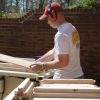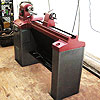I have to cut a template for a curved chair leg on the bandsaw out of 1/4" plywood and it's not very smooth. I tried using a sanding attachment on my DP but that didn't help much. Now there are just undulating high and low points, and I don't want to oversand.
There are six different shallow arcs for the back leg of the chair, so making a jig for the router would be very difficult.
Since I'm going to use this piece of ply as the template for the full size pieces with a flush trim bit, I need it to be spot on smooth. How can I do this? I think a spokeshave would be the right tool for the job? I know the plywood would dull the blade a bit faster, but I'm not that concerned about it.




 Reply With Quote
Reply With Quote








